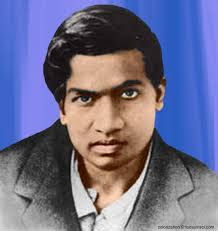srinivasa ramanujan of contribution
Ramanujan
Ramanujan is a born on (Dec 22,1887-April 26,1920) in erode.He was one of indian's greatest mathematical genius.His father worked in kombakonam as a clerk in a cloth merchant's shop. Ramanujan initially developed his own mathematical research in isolation.It was quickly reongized by indian mathematicians.In 1909 married ten year old girl s.janaki Ammal .In 1911 his first paper published,17 page works on bernoulli numbers -jouneral of the indian mathematical society. In 1913 he began a postal partership with the english mathematician G.H.Hardy at the unverisity of cambridge,England.In 1917 he was hospitalized,his doctors fearing for his life.By late 1918 his health had improved;he returned to india in 1919.But his health failed again,he died on 1920 in kombakonam.
contribution:
Ramanujan made substantial contribution to the analytical theroy of number and worked on elliptic
fuctions,continued fractions and infinite series.He worked an divergent series.He sent 120 theroem
on imply divisibility properties of the partition fucntion.He gave a meaning to eulerian second integral
for all values of n(negative,positive and fractional).
Hypo geometric series: He worked hypo geometric series, and investigated
relations between integrals and series. He was to discover later that he had
been studying elliptic functions. Ramanujan’s own works on partial sums and products of hyper-geometric series have led to
major development in the topic.
· Goldbach’s conjecture: Goldbach’s conjecture is one of the important illustrations of
ramanujan contribution towards the proof of the conjecture. The statement is
every even integer greater that two is the sum of two primes, that is, 6=3+3 :
Ramanujan and his associates had shown that every large integer could be
written as the sum of at most four (Example: 43=2+5+17+19).
· Partition
of whole numbers: Partition of whole numbers is another similar problem that
captured ramanujan attention. Subsequently ramanujan developed a formula for
the partition of annumber, which can be made to yield the required result by
a series of successive approximation. Example 3=3+0=1+2=1+1+1;
· Numbers: Ramanujan studied the highly composite numbers also which are
recognized as the opposite of prime numbers. He studies their structure,
distribution and special forms.
· Fermat Theorem: He also did considerable work on the unresolved Fermat theorem,
which states that a prime number of the form 4m+1 is the sum of two squares.
· Ramanujan number: 1729 is a famous ramanujan number. It is the smaller number
which can be expressed as the sum of two cubes in two different ways- 1729 = 13 + 123 = 93 + 103
· Cubic Equations and
Quadratic Equation: Ramanujan was shown how to solve
cubic equations in 1902 and he went on to find his own method to solve the
quadratic. The following year, not knowing that the quintic could not be solved
by radicals, he tried (and of course failed) to solve the quintic.
· Euler’s constant : By 1904 Ramanujan had began to undertake deep research. He
investigated the series (1/n) and calculated Euler’s constant to 15 decimal places.


Comments
Post a Comment